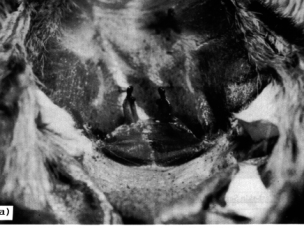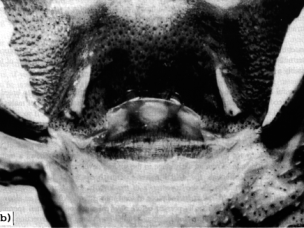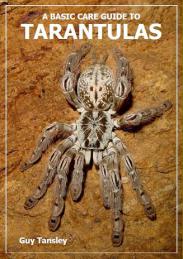
Cast-skin sex determination of tarantulas - a 'what to look for' guide'
Guy Tansley
Many tarantula keepers are aware that successful sex determination of a tarantula from their cast skin is possible from as early as the fourth moult with the aid of a stereoscopic microscope. The accompanying photographs, however, are intended as a simple guide of "what to look for" if such an instrument is unavailable to the amateur.
Concentrating on female tarantulas and those well past their sixth moult, the process of sex determination is relatively easy - requiring little more than a fresh cast skin, a pair of forceps and possibly a small hand lens.
Successful determination is important in many ways if, in the future, you plan to breed from your stock. Feeding rates can be increased or reduced to coincide with the arrival of males, specimens can be sold as a guaranteed sex so fulfilling the customer’s requirements and, if so, immature males can be purchased at a lower price as a future investment (not that anyone breeds tarantulas for the money!).
The photographs are basically to show the beginner the well-defined sex organs of the female tarantula: (a) shows a mature female Psalmopoeus cambridgei and (b) shows a mature female Lasiodora parahybana. From an early stage in the spiders development, the signs of a female are quite obvious and although the actual paired spermatheca aren't fully formed, successful determination is possible with the appearance of the heavily folded area known as the uterus externus (the large upward, rather curved piece of semi-transparent 'skin') and an alcove forming a large lower lip. This lip is usually present before any real signs of the actual spermathecae are developed and again, there is a marked difference in the immature male. Inspection of a suspected male cast skin is again obvious if the specimen is fairly large as none of the above features are present. Note: these photographs both represent examples of paired spermatheca, but some species have fused spermatheca forming a large fold behind the uterus extemus in species such as Brachypelma hamorii.
If determination is required earlier in the spiders development then things become slightly more complicated and I recommend either sending your spiders fresh moult to one of the registered sexing practitioners (details in the front of the BTS Journal) or reading further on the subject: "Sex Determination Of Immature Theraphosid Spiders From Their Cast Skins" - by Kathleen & John Hancock, for example.
Matching these photographs to line drawings in the above-mentioned book will give a better idea of what the female epigynum area and spermatheca actually look like in relationship to the other features (book lungs, etc. seen here as the large white areas on either side of the central epigynum). Now all you have to do is wait for your young tarantula to moult!
CAUTION: please be responsible! Keep these photographs well away from immature male tarantulas!
This article first appeared in the Journal of the British Tarantula Society, 13 (2): 55-57 (1997).



